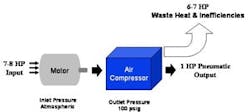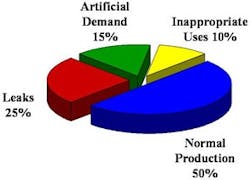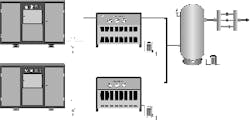Configure your compressor system for optimum efficiency
Industrial compressed air users often misinterpret the role the air compressor plays as an energy source in support of manufacturing. Air compressors don’t supply the air directly to the production demands: The connecting pipes serve that purpose. As such, the energy extracted from the system to perform the required tasks actually comes from air already in the pipes. The compressors replenish that air as it’s consumed. This is an important distinction to understand when configuring a compressed air system to perform at optimum efficiency.
Every air system reaches a balance between the air the compressors supply to the air distribution system and the air the downstream users withdraw from the distribution system. The energy that compressors input will equal the energy the users consume plus the system’s inherent inefficiencies. Anything left over either goes into or is released from storage. The basic equation representing this fact is:
Energy in = energy expended +/- energy stored
Changes occurring to either side of the equation result in the system re-balancing at a new point. Taking proactive, positive measures to manipulate the balance between supply and demand ensures the system always operates at its optimum energy efficiency. Compressed air is an inefficient energy source: Putting between 7 and 8 electrical horsepower into the compressor motor gives only 1 pneumatic horsepower of output to the system (Figure 1).
Figure 1. Most of the energy input to a compressor is lost and unable to perform useful work.
This is a typical distribution of the air consumption in a manufacturing operation.
Vs = ΔP x Vf/Pa
where Vs = the stored volume
ΔP = change in pressure
Pa = atmospheric pressure
Vf = the vessel’s fixed volume
Pressure changes in the storage vessel are based on the flow of air into and out of the receiver. If more air flows out than in, the air expands into the piping distribution system and the internal pressure decreases. Conversely, if the air flow into the receiver exceeds the outflow, the delivered air increases the pressure in the piping distribution system. Monitoring the outlet pressure and controlling the release of the air from storage by means of an intermediate pressure/flow control produces a stable reference point for balancing the system. The results:
- A reliable, stable compressed-air source for production purposes.
- Fewer compressed air-related problems and work stoppages.
- Energy savings from optimizing system efficiency.
An unanticipated compressor shutdown usually dictates the minimum amount of storage. To prevent serious production interruptions while the standby compressor starts, comes on line and begins to contribute air, storage must sustain the system. The required amount of storage, therefore, depends on the compressor capacity and the how much pressure degradation can be tolerated before production begins to shut down.
If, for example, the standby compressor takes 30 seconds to begin filling in for a failed 100 hp compressor rated at 500 scfm, and atmospheric pressure is 14.5 psia, the storage requirement is 250 cf (500 scfm x 1 min./60 sec. x 30 sec.). If the storage pressure is allowed to degrade 15 psi during those 30 seconds, the receiver capacity would be:
Vf = (Vs x Pa / ΔP) x 7.481 gal/cf
Where Vf = Receiver volume
Vs = 250 cf
Pa = 14.5 psia
ΔP = 15 psi
In other words, a fixed volume of 1,870 gal (250 x 14.5/15 x 7.481) will release 250 scf while dropping 15 psi in pressure. If the storage pressure is allowed to degrade only 5 psi during the 30 seconds, the receiver capacity would be 5,500 gal (250 x 14.5/5 x 7.481). These examples clearly demonstrate the relevance of the allowable pressure change.
Demand surges that cause flow spikes also influence the storage requirement. Evaluate them to determine if additional storage is needed either in the compressor room or at the local workstations to mitigate unacceptable pressure fluctuations.
The energy required to keep a system in balance comes from a combination of storage and available excess compressor capacity. Running a compressor partially loaded provides the unused reserve that can be drawn upon as needed. Partially loading a compressor, however, can be inefficient and costly, particularly if the compressor is oversized.
In fact, an unloaded, fixed-speed compressor can consume 20% to 25% of its rated horsepower even when idling. Storage, therefore, must be sufficient to allow an unloaded compressor to time out and shut down, even during short-duration events. The compressor would come online only when the operating compressor(s) plus storage could no longer sustain the minimum system pressure.
Using motor horsepower as an energy reserve is costly. The better approach is to take advantage of the storage-based reserve in advance of the intermittent peak demands and keep unloaded compressors shut down.
Speed factor
Compressors with variable-speed drive (VSD) change the storage variables in the balance equation because they have no consequential cost penalty from operating partially loaded. Horsepower is essentially matched to the demand load. Oversizing a VSD compressor to provide an energy reserve is an acceptable practice. For example, if a system needs 100 hp in reserve, a 200 hp VSD compressor could run at 50% load without introducing appreciable waste and inefficiency. In systems with VSD compressors, the energy required to maintain the system balance can rely more on a reserve of rotating motor horsepower and less on storage than a system configured with only fixed speed machines (Figure 3).
This schematic illustrates a typical application of a VSD with intermediate control. (Block diagram courtesy of Tom Taranto and ConservAIR)
The storage required to swing a trim compressor into the base position without interrupting production in the event of an unanticipated compressor failure must still be addressed. Also, VSD compressors frequently are networked with fixed-speed machines and centrifugal units. Proper application of storage ensures the VSD always can trim the system and not cause other networked compressors to load up or blow off.
Applying storage to control the system balance is essential for optimizing the energy efficiency, regardless of the compressor configuration. Storage ensures that a stable, reliable source of compressed air always is available for production. Effective compressor sequencing can be automated in a balanced system. The reduced air consumption from leak management and the elimination of wasteful practices and inappropriate uses will fully translate into real energy savings back at the compressor motors. You can profile the system, design the storage response, and then control the energy balance of the system at the optimum level.
Bob Wilson is the products manager at Pneumatech LLP in Kenosha, Wis. Contact him at [email protected] and (727) 866-8118.
Figures 1 and 2 courtesy of ConservAIR Energy Management



